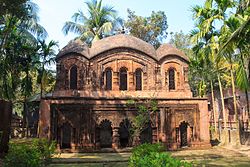Madaripur District
District in Dhaka, Bangladesh From Wikipedia, the free encyclopedia
District in Dhaka, Bangladesh From Wikipedia, the free encyclopedia
Madaripur (Bengali: মাদারীপুর) is a district in central Bangladesh and a part of the Dhaka Division.[4]
Madaripur
মাদারীপুর | |
|---|---|
 Madaripur Rajaram Mondir | |
 Location of Madaripur District in Bangladesh | |
 Expandable map of Madaripur District | |
| Coordinates: 23.17°N 90.10°E | |
| Country | |
| Division | Dhaka |
| Named for | Sufi Syed Madar |
| Headquarters | Madaripur |
| Government | |
| • Deputy Commissioner | Mohammad Marufur Rashid Khan |
| • District Council Chairman | Munir Chowdhury [1] |
| Area | |
| • District | 1,125.69 km2 (434.63 sq mi) |
| Population | |
| • District | 1,293,027 |
| • Density | 1,100/km2 (3,000/sq mi) |
| • Urban | 315,471 |
| Demonym | Madaripuri-Bangali |
| Time zone | UTC+06:00 (BST) |
| Postal code | 7900 |
| Area code | 0661 |
| Geocode | BD.DA.MD |
| ISO 3166 code | BD-36 |
| HDI (2018) | 0.649[3] medium · 3rd of 21 |
| Website | www |
Madaripur subdivision was established in 1854 within Bakerganj district. In 1873, it was separated from Bakerganj and annexed to Faridpur district. Madaripur subdivision was turned into a district in 1984. Madaripur district was named after the Sufi saint Sayed Badiuddin Ahmed Zinda Shah Madar (d. 1434 CE).
Madaripur district has 3 parliamentary seats, 5 Upazilas, 5 police stations, 4 municipalities, 59 Union Parishads, 1,062 villages and 479 Mouzas.[5]
According to the 2022 Census of Bangladesh, Madaripur District had 313,273 households and a population of 1,293,027 with an average 4.06 people per household. Among the population, 254,175 (19.66%) inhabitants were under 10 years of age. The population density was 1,149 people per km2. Madaripur District had a literacy rate (age 7 and over) of 74.93%, compared to the national average of 74.80%, and a sex ratio of 1100 females per 1000 males. Approximately, 24.40% of the population lived in urban areas. The ethnic population was 508.[2]
| Religion | 1941[8]: 100–101 | 1991 | 2001 | 2011 | 2022[2] | |||||
|---|---|---|---|---|---|---|---|---|---|---|
| Pop. | % | Pop. | % | Pop. | % | Pop. | % | |||
| Islam |
442,755 | 70.49% | 916,021 | 85.68% | 1,001,316 | 87.35% | 1,023,702 | 87.80% | 1,146,678 | 88.68% |
| Hinduism |
184,309 | 29.34% | 146,669 | 13.72% | 143,093 | 12.48% | 141,097 | 12.10% | 144,904 | 11.21% |
| Others [b] | 1,047 | 0.17% | 6,486 | 0.60% | 1,940 | 0.17% | 1,153 | 0.10% | 1,445 | 0.11% |
| Total Population | 628,111 | 100% | 1,069,176 | 100% | 1,146,349 | 100% | 1,165,952 | 100% | 1,293,027 | 100% |
Muslims make up 88.68% of the population, while Hindus are 11.21%. The Hindu population has decreased from 1991 to 2011, and grew much slower than the Muslim population from 2011 to 2022. There is a small minority of 1,300 Christians in the district.
The total number of educational institutions in Madaripur District is 213.
There are about 10 rivers in Madaripur district. They are -

Seamless Wikipedia browsing. On steroids.
Every time you click a link to Wikipedia, Wiktionary or Wikiquote in your browser's search results, it will show the modern Wikiwand interface.
Wikiwand extension is a five stars, simple, with minimum permission required to keep your browsing private, safe and transparent.